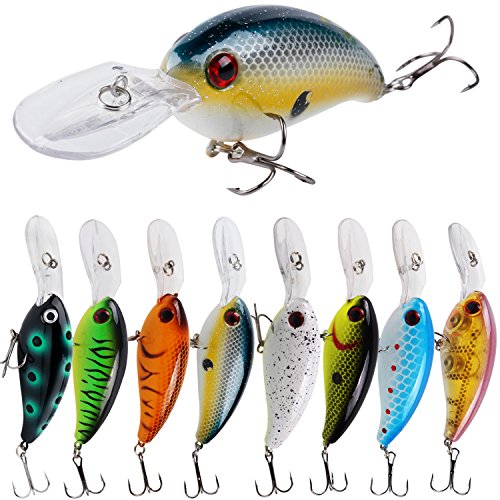If you hope to catch a ten-pound bass, secure the appropriate big-bass lures and make sure you apply the right fishing technique. To increase your chances, fish in the late spring, preferably early in the morning or evening. Be persistent and wise.
Our society is obsessed with size. The bigger, the better. And fishing is no exception.
The larger the fish you catch, the better angler you are. Hence, catching an average 3 to 5-pound bass or even a heavyweight 7-pound specimen won’t satisfy many fishermen. They dream about a ten-pounder.
So, how to catch a ten-pound bass?
Such bass cannot be found everywhere. Hence, you must be lucky enough to live in an area where scoring a monster bass is possible.
You should read this article even if you are not as fortunate. It is written with the help of some of the greatest big bass anglers. Do not miss out on their wisdom! It might be the only thing standing between you and the giant bass you are dreaming of!
Where To Find Big Bass?
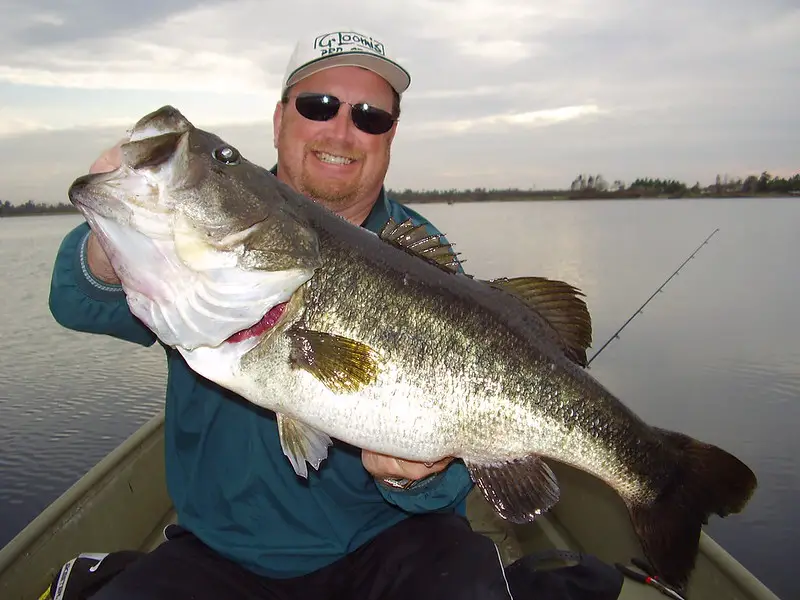
When searching for giant bass, you have to go where they live. Monster bass weighing ten pounds and over are extremely rare. To get that big, bass have to live in the right conditions. Hence, even though you can target bass in all 50 US states, you have the highest chance of catching the biggest bass when fishing in the South.
Why is that so?
Bass living in warmer climates enjoy an abundance of food and a prolonged feeding season. In short, they have more opportunities to grow big and fat. Hence, Florida-strain largemouths typically weigh around 7 lbs – sometimes even 10!
Let’s see where to look for a ten-pound bass.
Ponds And Lakes Big Bass Hotspots

You might live near a 10-pounder lake and not even know it. Even if you do, you must know how to locate bass this big.
As I have already said, lakes with Florida-strain fish are the best choice if you’re hoping to score a perfect 10. These largemouths are genetically superior to the northern-strain bass. Yet, even genetically superior bass fry cannot escape predators unless they have proper coverage to hide in. For this reason, the best big-bass lakes usually have thick grass beds or trees growing from the water.
Bass lake hotspots also include::
- Horizontal cover with overhead protection (toppled trees)
- Riprap (crushed rock) along the shoreline
- Docks
- Heavy aquatic vegetation (lily pads, canes, weeds, bulrushes)
- Lake points (usually near the entrance of a creek or cove)
Big bass need to feed well. Their food must be packed with valuable nutrients that will enable them to reach their peak size and give them enough energy to hunt. Most big-bass-producing lakes and ponds are loaded with bass-specific prey, such as tilapia and gizzard shad.
A fish finder can help you find schooling fish and the structures bass prefer to harbor around. It might aid you in catching a ten-pounder, too!
Water quality plays a crucial role, too. In areas where there is sewage discharge or industrial waste, vegetation dies off, baitfish scatter, and bass cannot thrive. If the water quality is poor, fish are unhealthy and cannot reach their maximum size or performance.
Warm temperatures keep bass active throughout the year. They might go offshore to deeper points during the summer when temperatures are very high, but they never stop feeding. Shallower points near the shoreline or the mouth of small bays or pockets are bass factories during spring and fall. In the summer, these spots are visited only early and later in the day.
In general, the clearer the lake water is, the deeper the large bass will be. This is especially true for Smallmouths and Spotted bass that prefer deeper water. This deep water often harbors the largest lake bucket mouths, too.
River Big Bass Hotspots
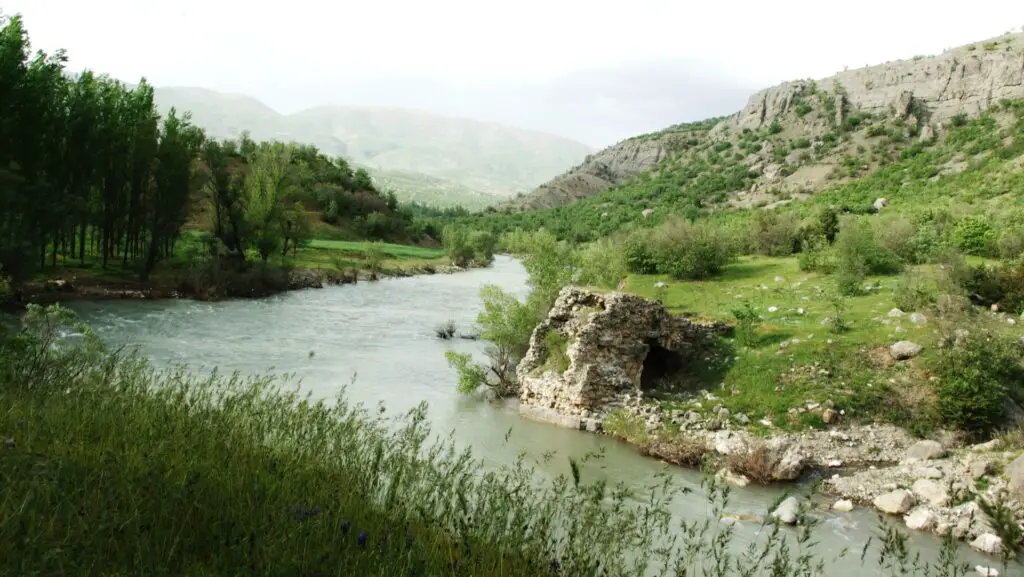
Fishing for huge bass in rivers does not differ much from lake fishing. Bass inhabiting moving waters are as structure-oriented as their lake counterparts. You should consider river currents, bends, bottom slopes and drops, existing structures, and how giant bass relate to such.
Submerged trees are, once again, the hottest zones to search for large fish. They will usually pile up where the bottom slopes and the current turns. Sharp drops on both sides of a point are perfect for bass to prey on smaller fish. You should also target deep water up against the bank.
In open water, bass often lose their prey. They need a structure or a deep riverbank to pin down the fleeing forage.
The ideal feeding spot for river bass is a two-foot deep sand bank that suddenly drops to 10 feet and then goes up again. Ideally, it has some eelgrass too! In smaller and shallower rivers and creeks, large river bass usually find cover in shoreline cover (brush, fallen trees) and aquatic plants growing from the river bank or on the water surface.
River giants often hide in a darkened environment and wait for forage fish. They are too big and lazy to chase after their prey. They prefer to lay in a hole just out of a fast current and wait for an easy meal.
To catch big bass, target the following areas:
- “Holes” cut out by a current
- Small sinkholes
- Depressions
- Outer bends on slow-moving tributaries
- Deeper creeks flowing into/out of a river channel
- The intersection of two tributaries
- Quieter waters near tumbling ripples
Waiting on a giant bass to feed might require a lot of patience. Once you find an ideal spot with a perfect cover, depth, and current, be persistent. Work this spot at least five times a day until the big predators come to feed and fall into your trap.
It might take you as much as 30-40 casts. Considering that the action slows down after every 3 to 4 strikes, it would be wise to find a few similar areas nearby and move between them. It will increase your chances of catching large river bass.
The 11 Best Places In The World To Catch The Biggest Bass
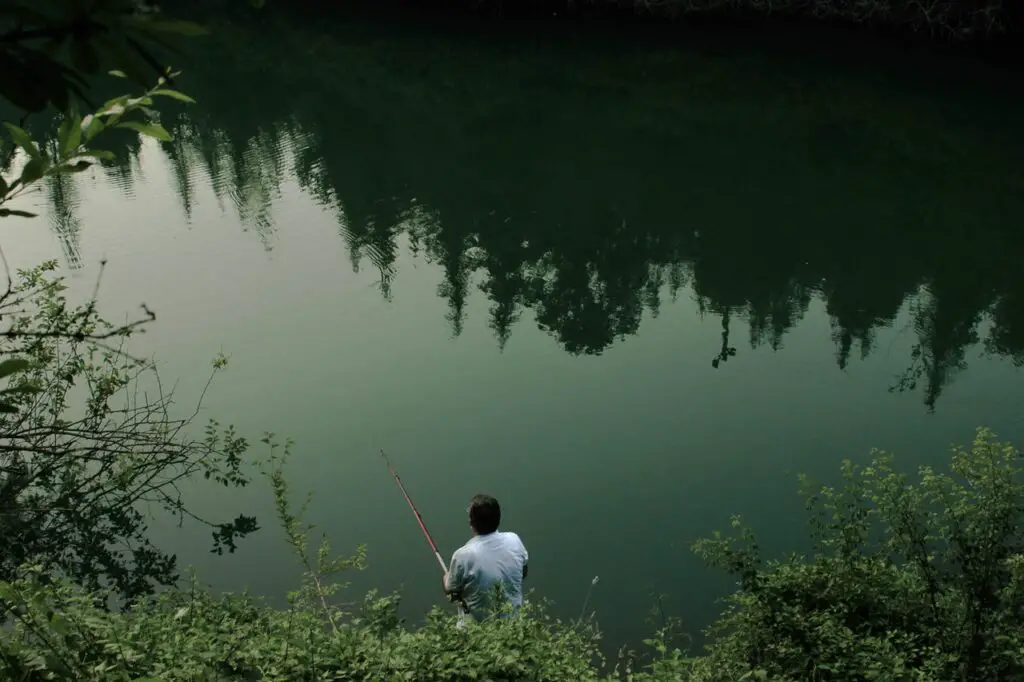
As you are about to discover, your desire to catch a 10-pounder is likely to take you to warmer regions. Let’s see which places should be your top priority!
- Lake Fork, TX
Lake Fork, Texas, is a well-known and highly-popular trophy reservoir packed with big Texas bass. It keeps pumping out huge fish thanks to its blooming vegetation and bounty of baitfish, such as shad.
The Texas record bass of 18 pounds has been caught in this lake!
- Toledo Bend, TX
As a part of its Lunker Bass Program, in 2015, the Toledo Bend Lake Association awarded 139 fiberglass replicas for bass weighing over 10 pounds caught in their waters. Still, I would not recommend this lake to an inexperienced bass fisherman since it is rather hard to navigate.
lake record bass
- Lake Okeechobee, FL
Lake Okeechobee battles fluctuating water levels, but it has always managed to bounce back thanks to having such a healthy stock of bass. Fish grow big thanks to good conditions and plenty of peppergrass and eelgrass.
- Clear Lake, CA
Clear Lake is deemed one of the best northern California lakes. It is home to numerous trophy bass expeditions and a perfect place to use glide baits or swimbaits that imitate local baitfish – especially the Clear Lake hitch.
Many northern California lakes have active fish year-round. Yet, Clear Lake attracts most trophy hunters due to its versatile terrain and numerous possibilities for targeting big bass.
- San Joaquin Delta, CA
Florida-strain bass, combined with rich vegetation, miles of marshy pools, inlets, and ponds, to make the San Joaquin Delta a trophy reservoir straight out of textbooks.
- Pickwick Lake, AL/CT
Pickwick Lake is a bass factory due to its significant grass resurgence. The lake record bass weighs 14.58 pounds!
You can also find 10-pounders in Chickamauga, another Tennessee impoundment. I recommend visiting this area if you prefer waters with slightly less fishing pressure.
- Lake Berryessa, CA
According to a bass-pro Ish Monroe, Lake Berryessa might be home to the world’s record spot, smallmouth, and largemouth bass. The fact that this lake is still fairly undeveloped and unpressured is a reason more to visit it on one of your future trophy bass expeditions.
- Falcon Lake, TX/MX
In 2008, Mexico’s Falcon Lake earned its glory by producing the record B.A.S.S. four-day total (130 pounds for twenty bass). Hence, even though secluded, the lake had to endure extreme fishing pressure, but it seems to have eased off recently.
Thanks to mesquite and huisache bushes and plenty of tilapia to feed on, Falcon Lake is now home to a healthy population of hefty bass, including those in the double digits.
- Lake El Salto, MX
El Salto has been a popular destination for bass anglers for over three decades. It is packed with tilapia and provides new cover and life by fluctuating 30 to 40 feet per year.
- Lake Letsibogo, Botswana
If you are up for an adventure of your lifetime, visit Lake Letsibogo in southern Africa. It holds both Florida-strain and northern-strain bass, but the former produce quite a few double-digit fish. Just beware of crocs and hippos!
- Tennessee River, The Southeastern US
If you prefer fishing on rivers, try the Tennessee River. It produces some of the most renowned smallmouth and largemouth bass. This lake also forms acclaimed bass reservoirs such as Lake Guntersville, Kentucky Lake, and Pickwick Lake.
When To Fish For Big Bass?

The Best Season
The best time of the year for giant bass fishing is late spring or early summer. Even though April is deemed the best month in most regions, if you hope to catch a monumental specimen, you should wait a bit longer and give the fish time to grow 10-pounds big.
The Best Time Of The Day
The best time of day to fish for large bass is during the lowest light hours. Hence, you have three options:
Early Morning (Dawn Until 8.00 AM)
Baitfish are more active and bass more confident in the early morning hours. It is a perfect combo for anglers hoping to score a ten-pounder!
Late Afternoon (5.00 PM Until Dusk)
When the sun starts to set, large bass take advantage of lower light conditions and fill their tummies. It is especially true for hot summer months.
Night
Nighttime is the best time of day to fish for bass, especially in the summer. Ten-pound heavy bass are experienced hunters and avoid anglers by being more active during the evening hours. Give night fishing a try!
After Rain
Fishing after rain can improve your chances of catching the biggest fish. Rain aerates the water and can also increase turbidity making the bass more active. Bass natural feeding holes receive some additional current followed by yummy forage washed into the river, too.
The Ideal Water Temperature In Which To Target Big Fish
The ideal water temperature for big bass fishing ranges from 74 to 79° F. Yet, bass feed actively in water temperatures between 61-84° F.
Bring a thermometer to identify the best fishing spots! When the water temperature reaches its summer and winter extremes, opt for deep-bass fishing.
The 10 Best Big Bass Fishing Rigs, Bait, & Lures
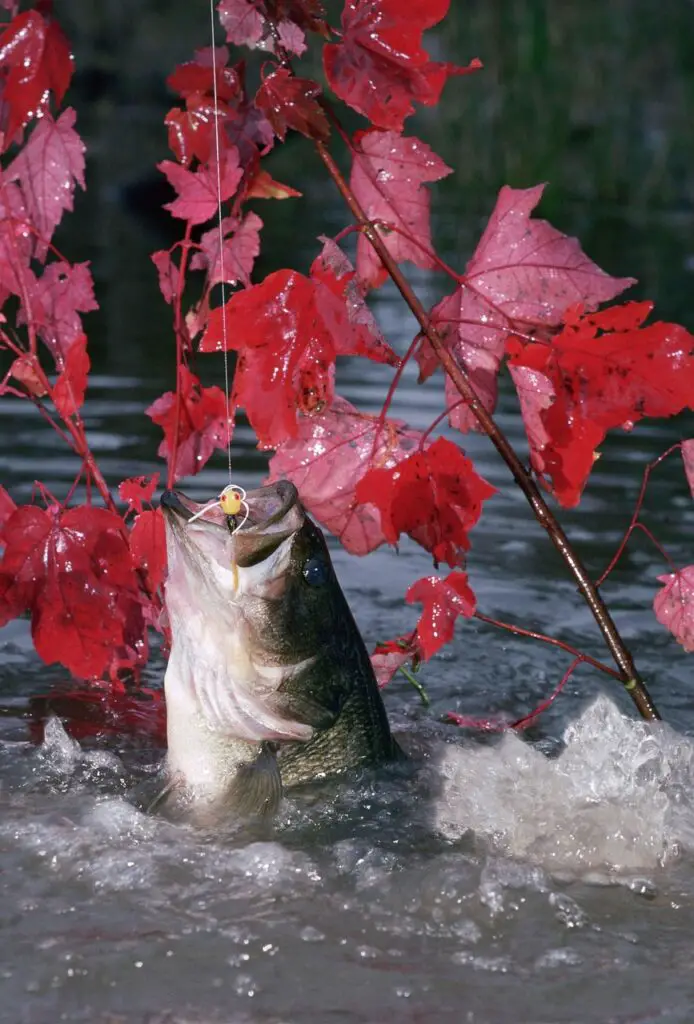
Bass that are 10 pounds or more won’t chase after a meal very often – they are already educated and have developed wiser tactics. They also know how to choose baitfish worthy of their effort. Hence, they will make a move only for specific bait.
Check out the following list!
- Soft Swimbait
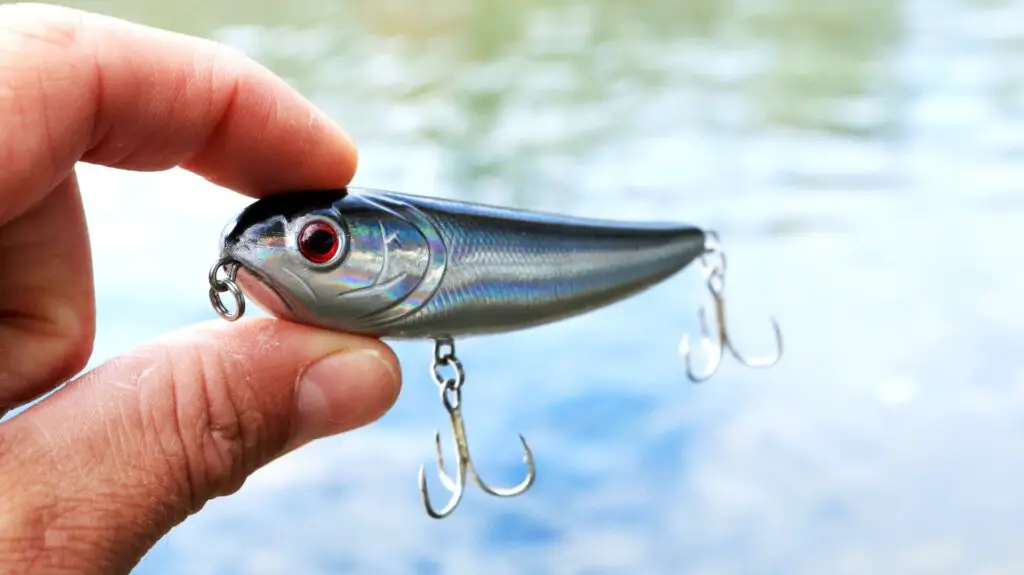
I have already mentioned this lure as one of the best for targeting largemouth bass at Clear Lake in California. However, it can bring in giant bass, no matter where you fish.
If there are 10-pounders present, they will have trouble resisting the ultra-fluid motion of a soft swimbait. Even the wariest of fish will take this soundless bait.
All soft swimbait are inspired by the legendary No products found.. Nowadays, you have two options:
- In-line soft swimbait
- Line-through soft swimbait
These artificial lures can be from 3 inches up to a foot long. However, when targeting double-digit fish, you should best opt for the 7-inch in-line swimbait and use it from dawn to dark. Be sure to try Bull Shad swimbaits, too!
- Glide Bait
These single-jointed artificial lures produce a unique S-motion swimming action to draw fish. Experienced anglers can make glide bait turn 180 degrees when needed. Hence, they are ideal for attracting bass in clear waters.
Be patient. Big lures are not meant to deliver multiple fish – their purpose is to bring in the trophy fish. Hence, you might get fewer bites, but they are sure to bring a smile to your face.
The most productive glide bait come from Japan and can cost serious money. However, even the cheaper models, such as the Duo Realis Onimasu, do the job quite well.
Interested in using a glide bait yourself? Watch the following video to learn the basics:
- Carolina Rig
A Carolina rig offers a subtle presentation and decent water coverage. Replicating lizards, crawdads, and shad, it works wonders in outside grass lines during the spring. However, it also proves efficient on offshore structures in the summer heat.
Carolina rigs can be applied in both deep and shallow water, as well as in heavy currents. All you need to do is adjust the weight to match the current conditions. When targeting big bass, go for the legendary Zoom Brush Hog glide bait – they are the ultimate fish finders.
- Jig & Trailer
The jig and trailer are not outdated – they are top big bass producers. Try Strike King's Tournament Grade jigs that have been greatly improved. You can always change the trailer to adjust the weight, color, and fall rate.
If you want to learn how to use jig trailers, check out the following video:
- Oversize Crankbait
To catch an oversize bass hiding in the deeper water, use oversize crankbait. New models can pass the 20-foot diving mark, which was deemed impossible only a few years ago. In shallow water, opt for a big shallow-diving squarebill model.
- Big Topwater Bait
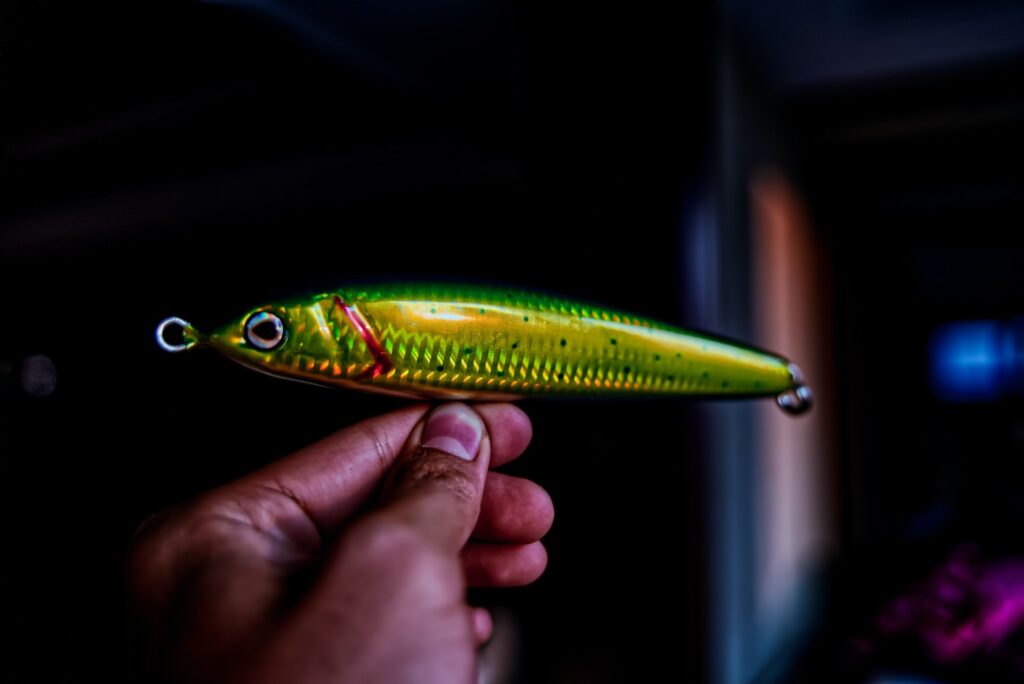
Big topwater bait attracts monster fish. The most successful among them is the Whopper Plopper. Retrieve this bait steadily, and you won’t have a problem tempting a reaction strike from the biggest bass on any lake.the Whopper Plopper
- Craws and Creature Bait
Craws and creature bait are a wise choice for flipping in tight cover. A big tungsten weight is best combined with a bite-size lure. These compact bait penetrate laydowns and heavy grass with no difficulty at all!
- Umbrella Rig
Umbrella rigs or Alabama rigs imitate a school of shad. They should be retrieved subsurface and are the best option for cold-water bass fishing in late fall and winter. This rig tempts suspended lethargic bass quite successfully but calls for a struggle too.
- Giant Worm
Plastic worms are the most versatile bass lures. They can be used at all depths and water colors. California anglers typically use deadly triple-laminate straight tailsup to 18 inches long. However, Mexican anglers would never renounce a 10-inch Power Worm.
Here is how to catch bigger bass using giant soft plastic worms:
- Yamamoto Senko
Yamamoto Senko has had quite a remarkable success story. It has caught more bass than many highly-productive baits.
You can choose between a fished Texas-style or wacky style. When targeting big bass, opt for the 7-inch model.
The 4 Best Big Bass Fishing Tactics

Just relying on bass fishing basics won’t cut it when pursuing a 10-pounder. You’ll need some advanced tactics.
The Best Tactic For Prespawn Big Largemouth Bass Fishing
Largemouth bass in southern US states spawn during late winter. If you hope to catch giant bass, you should use a Carolina rig and target the right depth.
How deep should you go?
Small males usually cruise the shallows during the pre-spawn period, but big females stay behind and harbor as much as 20 feet deep. They are typically very sluggish, too.
Big ladies will eventually visit the shallows too, but only for as long as it takes them to lay their bass eggs. Hence, if you want to catch one of them, you ought to stick to deeper water – at least 8 to 12 feet deep.
What bait should you use?
A Carolina rig will help you cover a lot of water without compromising natural presentation. You can tie a lizard imitation at the end of your rig or use a creature bait, such as a Zoom Brush Hog. Its beefy body can attract even the wariest fish on the bass scene.
The slower your retrieve, the better. Future bass moms are not there to feed. They stagnate and wait for the right time to move to shallower water and spawn. You have to draw their attention. Using the double-jointed Bull Shad Swimbait might help. 9-inch brush-tailed big baits that mimic the local baitfish are a great choice, too.
The main advantage of utilizing giant swimbait is expanding the strike zone. Big female bass will be able to see and hear the bait from afar, so you do not necessarily need to pinpoint a spot. What are the ideal conditions to look for big mamas?
The ideal water temp for largemouth bass fishing is 50 degrees Fahrenheit. If you brought a thermometer, as I advised you, now is the time to use it! The biggest females in the lake will typically spawn first. They start getting ready to feed quite early. Do not miss this window of opportunity!
Target thick grass, docks, and laydowns at the mouths of spawning flats. If you are hesitant to use bait with multiple hooks in such an environment, don’t be – just bring a lure retriever with you.
The Best Tactic For Using Crankbait
Crankbait can now reach the bottom in 20 feet of water. Hence, No products found.became one of the best-selling bait for pursuing big fish. Even the bass pro, Keith Combs, feels most confident using it!
What equipment do you need to cast crankbait properly?
A big crank calls for a big bass fishing rod. You should combine it with a sturdy 7-foot, 10-inch cranking rod and a small-diameter 15-pound fluorocarbon line that maintains the sway and sensitivity.
But where to go? It does not matter if you are targeting an east Texas trophy factory or a TVA reservoir – if you are hunting big fish in summer, you need to concentrate on long points or bars on the main lake.
A deep diving crank works wonders in deep water, but you can also use it in shallow areas and then work it into the depths. It can catch bass in 8 to 15 feet of water.
The Best Tactic For Sight Fishing
You might be afraid to rely on sight fishing when targeting the bass of your dream, yet, it can be a valid tactic when fishing on a lake during the spawning season in optimal visibility. Trying to tempt wary fish that can see you is a challenge, though.
As long as the lake you choose to target has gravel, an abundance of big fish, and is not super clear – you have a decent chance of scoring. Your approach will make all the difference, so forget about your jitters.
What areas to target?
Do not allow the bass to have a 360-degree view of you approaching it. Choose the areas that permit you to sneak up to the fish. Marshy waters covered in reed or tules are an ideal choice. Fishing near the dock is an excellent solution, too.
The heavy cover should give you a headstart by allowing you to move close enough to determine the direction the bass is facing. Once you discover this, you can readjust your angle accordingly.
How to present the bait?
Big female bass might not prioritize feeding during the spawning season, but that does not mean they won’t strike. Quite the opposite, mamas-to-be are highly aggressive and easily provoked.
Hence, the goal of your bait presentation is to agitate the females. Do not get overly excited and pull your lure off the bed as soon as a bass approaches or it won’t see it as a threat. Keep the bait in place, and slowly twitch it until you provoke a strike.
A bait that sways or creates small ripples while staying in one place will agitate your target fish quickly. For the best effect, use Missile Baits D Stroyer creature bait.
The Best Tactic For Jig Fishing In Spring
California anglers lean on swimbait, but jigs work wonders, too, especially in spring. Besides, jigs are far more versatile than any swimbait. Try a football-head jig in spring!
What is the ideal time of the day for jig fishing bass?
I hope you are an early bird! If yes, you can make the best use of a short morning feeding window to catch big jigged bass. Points and slight bends in a channel are prime spots to target.
How to present a jig?
To attract big lazy bass, you must keep the bait in their face until they are aggravated enough to strike. Stay in the same zone for as long as you can and slowly move the jig over the bottom.
What color of jig to use?
In clear water, your best choice is the green pumpkin jig. When the water is muddy, utilize black-and-red jigs. The trailers should match the local prey perfectly. It would be wise to swap them out daily, or even every couple of hours.
How Not To Lose A Monster Bass
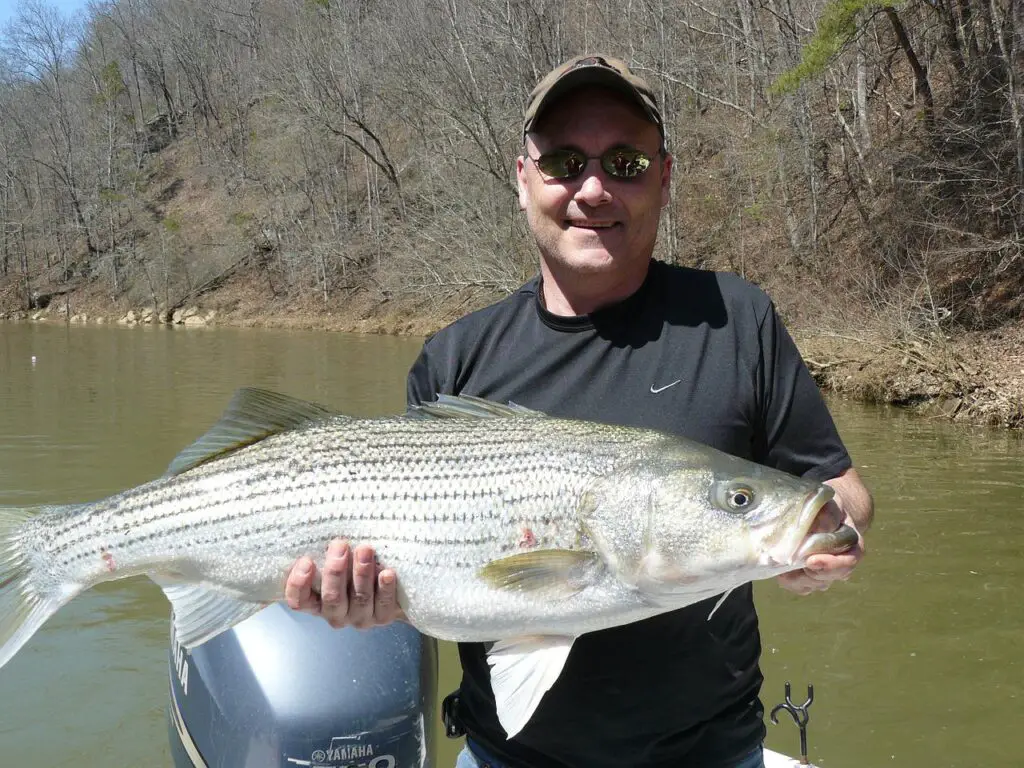
When big fish hits, we all feel euphoric. Unfortunately, anglers lose big fish all the time. I am sure you have also felt the pain of losing a good catch. No one likes to hear this, but it is usually the angler’s fault.
Here is what you can do to prevent it:
- Always run your fingers down the two feet of your line before you recast, making sure it has no weak spots. If you feel anything slightly suspicious, retie your lure.
- Do not swing hard on a trophy bass or you risk snapping the line. Set your drag properly from the start. You do not want it to be too tight – let it slip a bit.
- Keep your composure while fighting the big fish. Do not end the fight as fast as you can or play with the fish for too long.
- Once you bring the fish close, prevent it from jumping by keeping your rod tip about 10 inches under water. The goal is to keep the fish’s head submerged and wait until it calms down.
- When boat fishing for offshore bass, you must not crank down when you feel the strike. Pick up the slack between you and your catch early and then keep reeling. Slowing down can cost you your fish. You can rest once you bring the fish close to your boat.
If you are a newbie, start with a spinning reel. They are easy to use and have a solid and dependable drag system.
FAQs
Is a 10-pound bass big?
A 10-pound bass is definitely big. In fact, any bass that weighs more than five pounds is considered big, especially in northern US states.
Is a 10-pound bass good?
A 10-pound bass is a good catch no matter where you live. It is the undisputed benchmark, and you would have to be crazy not to appreciate it.
How old is a 10-lbs bass?
A 10-lbs bass is generally around 9.5 to 11 years old. However, Florida-strain bass weighing 10 lbs are sometimes less than five years old. Hence, big largemouth bass are not necessarily old.
What is a good weight for a bass?
Anything between 5 to 10 lbs is considered a good weight for a bass. However, it mostly depends on the strain of the bass.
What is a nice size bass?
A nice size bass is somewhere between 5 to 11 pounds and more than 15 inches long. Largemouth bass caught in the southern states are not considered trophies unless they are from 9 to 20 pounds. In the north, anything above 7-8 pounds is considered a nice size.
What size bass is considered a trophy?
Florida strain bass must be at least 9-10 pounds to be considered a trophy fish. A northern strain bass has a bar set much lower.
Final Words Of Wisdom
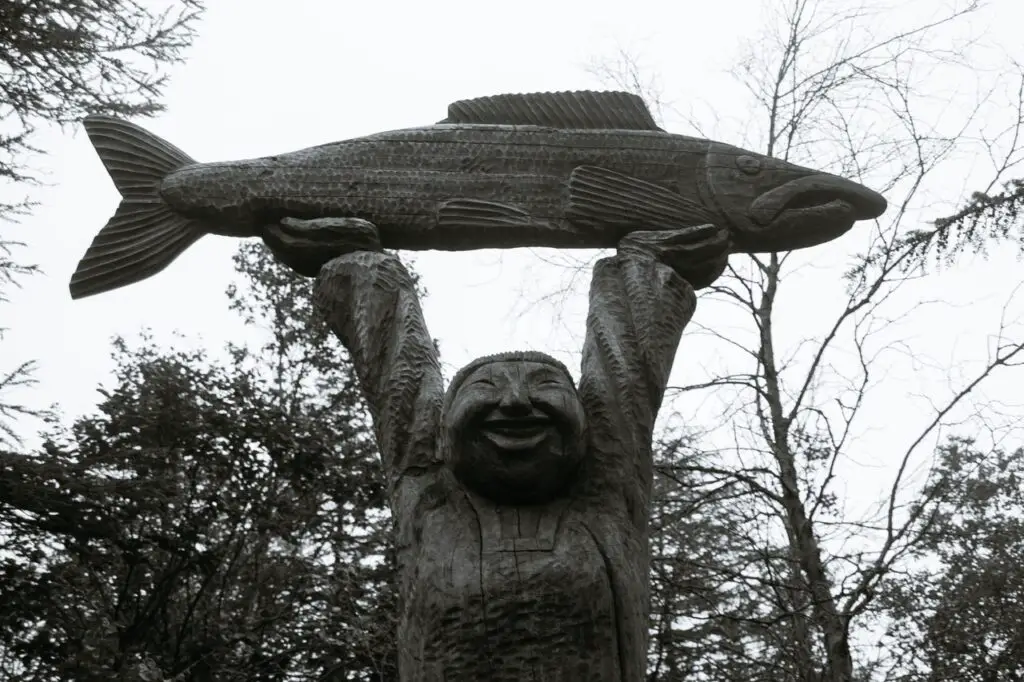
The pursuit of a big fish is a tale as old as time. If you share that dream, it is time to get on the water and make it a reality. You got the know-how to catch a true trophy bass now!
As bass gain weight, they become educated too, so you must educate yourself as well. Ask experienced bass guys for advice. You might get useful information I failed to mention here.
Please share your experience with the rest of us in the comment section! All bass fishers love exchanging information!




